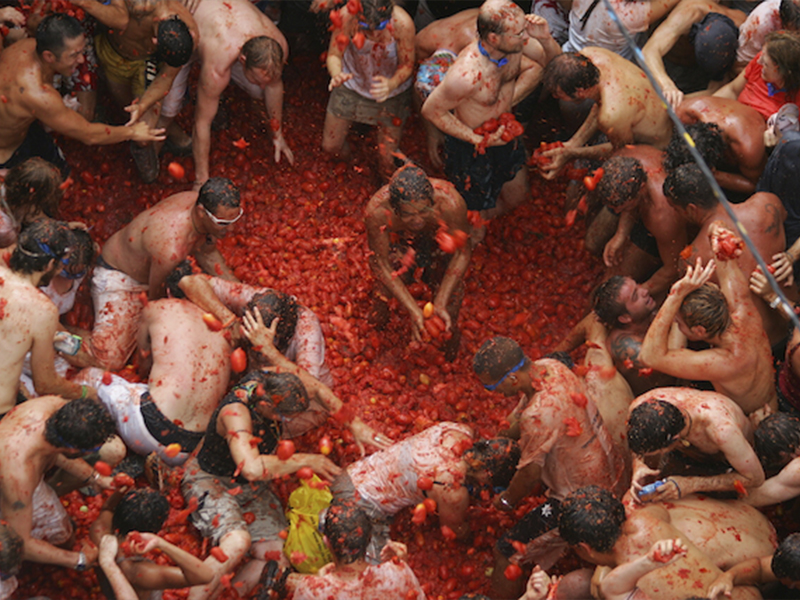La Tomatina, one of Spain’s most well-known and quirky festivals, is an event filled with fun, excitement, and tomatoes. Every year, thousands of locals and tourists gather in the small town of Buñol near Valencia to participate in a food fight like no other, where the main ammunition is ripe tomatoes. Let’s explore the rich history, traditions, and unique characteristics of this incredible festival.
The next event takes place this year on 30th August and you can book a package deal from a few nearby towns on Tomationa website.
Also read: Javea Festivals
History
The origins of La Tomatina are somewhat clouded in mystery, but the most accepted version dates back to the last Wednesday of August in 1945. During a parade in Buñol, a group of young people wanted to join the event, but in their enthusiasm, they knocked over a participant who was in a big head costume. The man, enraged, started hitting everything in his path, leading to a brawl. Nearby was a vegetable stand filled with tomatoes, which became the chosen weapon for the young people.
After the melee, the townsfolk decided to repeat the tomato fight the following year, making it a tradition. Despite some bumps along the way, including being banned during the Franco regime, La Tomatina gained popularity and was officially declared a Festival of International Tourist Interest in 2002.
Preparing for Battle
As La Tomatina’s fame grew, so did the number of participants. Nowadays, the local government has implemented measures to ensure safety and sustainability, limiting the number of participants and making tickets mandatory.
The preparation starts the night before with the “Palo Jabón,” a greasy pole with a Spanish ham on top. Participants climb the pole to reach the ham, while onlookers enjoy music, dancing, and fireworks.
On the day of the festival, trucks filled with ripe tomatoes roll into the Plaza del Pueblo. These tomatoes are grown especially for the event, and are of lower quality, ensuring they are soft and harmless.
The Battle Begins
At 11 am, the fight officially begins with the firing of water cannons. Participants, wearing old clothes and protective goggles, hurl tomatoes at each other, following a few critical rules, such as squashing the tomatoes before throwing to reduce impact.
The battle is intense but friendly, with laughter and playfulness being the main theme. After an hour, the cannons fire again, signaling the end of the tomato-throwing frenzy.
Cleanup
What’s left after the battle is a town covered in tomato pulp. The cleaning process is remarkably efficient, as fire trucks hose down the streets while participants use the water from public showers or the local river to clean themselves.
Interestingly, the acidic tomatoes act as a disinfectant, leaving the streets cleaner than before the event. Locals often comment on how the festival makes their town look refreshed and vibrant.
Impact and Controversy
La Tomatina has become a symbol of Spanish culture and a major tourist attraction, contributing significantly to the local economy. However, it’s not without controversy. Critics argue that the festival is wasteful, especially in a world where food scarcity is a pressing issue.
In response, organizers have emphasized the fact that the tomatoes used are of low quality and not suitable for consumption. Additionally, measures have been taken to reduce waste and ensure environmental sustainability, including composting the remnants of the tomatoes.
How to get to La Tomatina festival from Javea
Getting to Buñol from Javea is a journey that can be made by car, bus, or a combination of bus and train. Below, I’ll describe the different ways to get from Javea to Buñol.
By Car:
Driving from Javea to Buñol is perhaps the most straightforward method of travel. Here’s a step-by-step guide:
- Start on the AP-7: From Javea, you’ll need to get on the AP-7 motorway, heading northwest towards Valencia.
- Exit onto the A-3: Follow the AP-7 for about 100 kilometers until you reach the exit for the A-3, heading towards Madrid/Buñol.
- Take Exit 322: Continue on the A-3 until you reach Exit 322 for Buñol.
- Follow Local Roads: From the exit, follow the local roads and signs directing you into the town of Buñol.
The total driving distance is approximately 125 kilometers, and the journey typically takes about 1.5 hours, depending on traffic.
By Public Transport:
If you prefer to use public transport, you can reach Buñol by a combination of bus and train.
- Bus to Valencia: From Javea, take a bus to the central bus station in Valencia. This journey usually takes around 2 to 2.5 hours.
- Metro to Valencia Train Station: Once in Valencia, you can take the local metro to Valencia’s main train station (Valencia-Nord or Joaquín Sorolla, depending on your train).
- Train to Buñol: From Valencia’s train station, catch a Cercanías (local commuter train) to Buñol. Trains run regularly, and the trip usually takes around 40-50 minutes.
- Arrival in Buñol: Once you arrive at Buñol’s train station, the town center is within walking distance.
Summary:
Whether you choose to drive or use public transportation, getting to Buñol from Javea is relatively straightforward. Driving provides more flexibility and can be quicker, while public transport offers a chance to relax and enjoy the scenery. If you’re heading to Buñol for La Tomatina, be sure to plan ahead, as transportation options may be more crowded or require advance booking during the festival period.
Conclusion
La Tomatina is more than just a food fight; it’s a celebration of community, tradition, and the joy of living. The spirit of the festival reflects the zest and passion of the Spanish people and offers an experience that’s both unique and exhilarating.
Whether viewed as an opportunity to let loose and have fun or as a symbol of cultural identity, La Tomatina continues to draw people from all walks of life, ensuring that the streets of Buñol will be painted red with tomatoes for years to come. By understanding its rich history, traditions, and the social and economic impact, we can appreciate why La Tomatina is not just a local festival but a global phenomenon.


